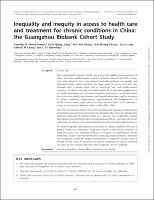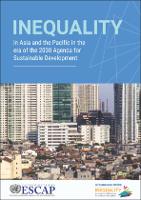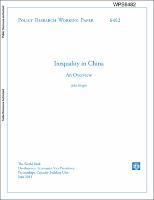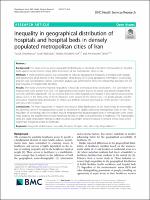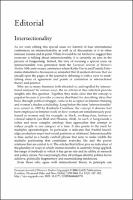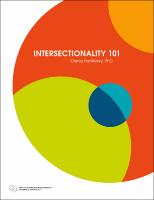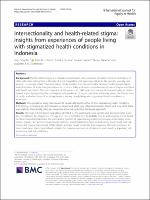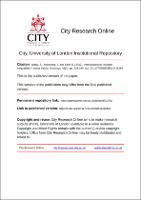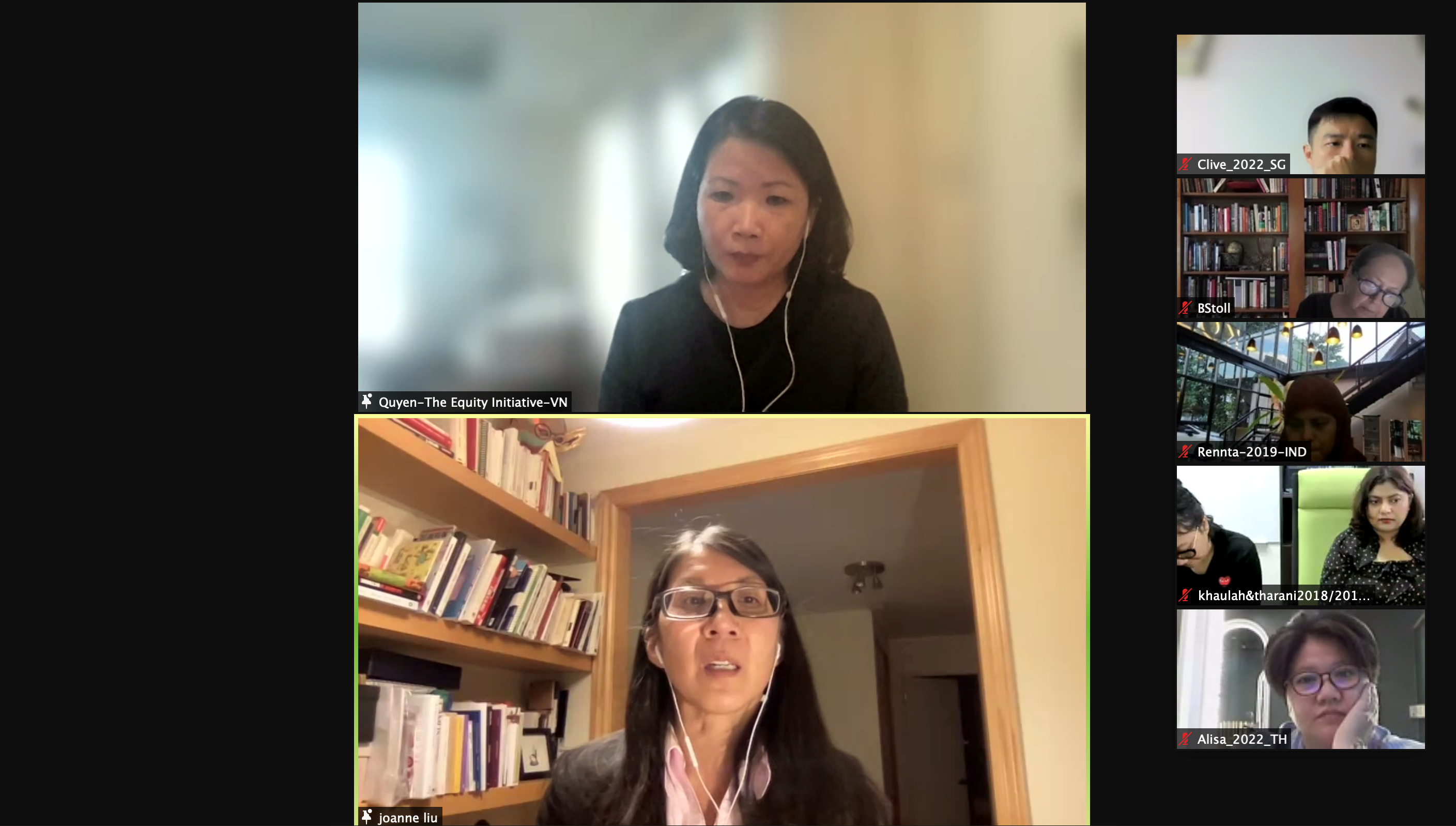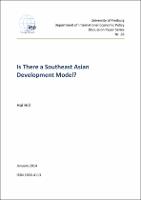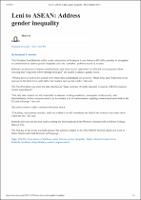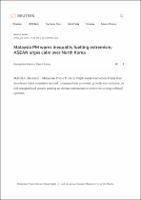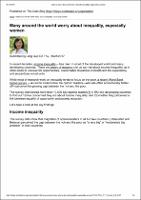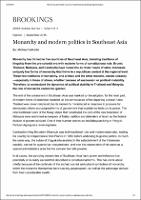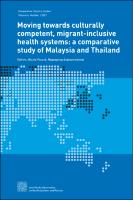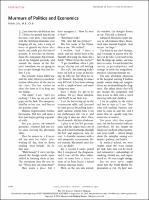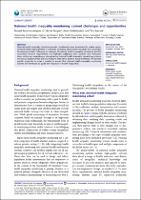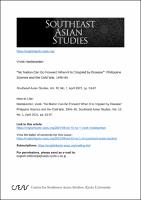Browsing by Title
Now showing items 132-151 of 229
-
Inequality and inequity in access to health care and treatment for chronic conditions in China: the Guangzhou Biobank Cohort Study
(2013)
Non-communicable diseases (NCDs) are a large and rapidly-growing problem in China and other middle-income countries. Clinical treatment of NCDs is long-term and expensive, so it may present particular problems for equality and horizontal equity (equal treatment for equal need) in access to health care, although little is known about this at present in low- and middle-income countries. To address this gap, and inform policy for a substantial proportion of the global population, we examined inequality and inequity in general health care utilization ... -
Inequality in Asia and the Pacific in the era of the 2030 Agenda for Sustainable Development
(United Nations, 2018)
This publication reviews the region's inequality trends, challenges and achievements and identifies policy gaps across the three dimensions of inequality--inequality of outcome, inequality of opportunity and inequality of impact. It also discusses the potential impact of rapid and disruptive technological advances, such as machine learning, and puts forward a broad set of policy recommendations for reducing all forms of inequality for the effective implementation of the 2030 Agenda for Sustainable Development and its core tenant of "leaving no ... -
Inequality in China
(Oxford University Press, 2014-10-30)
This paper provides an overview of research on income inequality in China over the period of economic reform. It presents the results of two main sources of evidence on income inequality and, assisted by various decompositions, explains the reasons income inequality has increased rapidly and the Gini coefficient is now almost 0.5. This paper evaluates the degree of income inequality from the perspectives of people’s subjective well-being and government concerns. It poses the following question: has income inequality peaked? It also discusses the ... -
Inequality in geographical distribution of hospitals and hospital beds in densely populated metropolitan cities of Iran
(BMC Health Serv Res, 2019-12)
Background: This study aims to assess geographical distribution of hospitals and extent of inequalities in hospital beds against socioeconomic status (SES) of residents of five metropolitan cities in Iran. Methods: A cross-sectional analysis was conducted to measure geographical inequality in hospital and hospital bed distributions of 68 districts in five metropolitan cities during 2016 using geographic information system (GIS), and Gini and Concentration indices. Correlation analysis was performed to show the relationship between the SES and ... -
Intersectionality
(European Journal of Women's Studies, 2006-08) -
INTERSECTIONALITY 101
(Institute for Intersectionality Research and Policy)
Interest in and applications of intersectionality have grown exponentially in popularity over the last 15 years. Scholars across the globe from a variety of disciplines, including sociology, political science, health sciences, geography, philosophy and anthropology, as well as in feminist studies, ethnic studies, queer studies and legal studies, have drawn on intersectionality to challenge inequities and promote social justice. This practice has also extended to policy makers, human rights activists and community organizers search - ing ... -
Intersectionality and health-related stigma: insights from experiences of people living with stigmatized health conditions in Indonesia
(International Journal for Equity in Health, 2020-12)
Abstract Background Health-related stigma is a complex phenomenon, the experience of which intersects with those of other adversities arising from a diversity of social inequalities and oppressive identities like gender, sexuality, and poverty – a concept called “intersectionality”. Understanding this intersectionality between health-related stigma and other forms of social marginalization can provide a fuller and more comprehensive picture of stigma associated with health conditions. The main objective ... -
Intersectionality: Multiple Inequalities in Social Theory
(SAGE Journal, 2012-04)
The concept of intersectionality is reviewed and further developed for more effective use. Six dilemmas in the debates on the concept are disentangled, addressed and resolved: the distinction between structural and political intersectionality; the tension between ‘categories’ and ‘inequalities’; the significance of class; the balance between a fluidity and stability; the varyingly competitive, cooperative, hierarchical and hegemonic relations between inequalities and between projects; and the conundrum of ‘visibility’ in the tension between the ... -
Interview with Global Health Crusader Dr. Joanne Liu
(The Equity Initiative, 2022-01-22)
Interview with Global Health Crusader - Dr. Joanne Liu Former International President of MSF; A professor at the McGill University’s School of Population and Global Health - Pandemic & Health Emergencies Interviewer: Duong Hoang Quyen -
Is There a Southeast Asian Development Model?
(Department of International Economic Policy Institute for Economic Research University of Freiburg, 2014)
The 10 states of Southeast Asia have combined to form the developing world’s most successful and durable regional grouping, the Association of Southeast Asian Na-tions, ASEAN. Economic integration among them is high and increasing. The ambi-tious ASEAN Economic Community is scheduled to take effect from December 2015, and should further accelerate this integration. But the socio-economic and institution-al disparities among them are also very large. This paper therefore asks the ques-tion, does it make sense to contemplate a ‘Southeast Asian ... -
Keynote Speaker- Chris Oechsli
(The Equity Initiative, 2022-01-21)
What does it take to lead one of the world’s foremost philanthropic foundations with a commitment to social justice and equity, while honoring the founder’s directive for a limited-life foundation? These are some of the ideas that Chris Oechsli discusses in this session. -
Leni to ASEAN: Address gender inequality
(Manila Bulletin News, 2017-11-07) -
Malaysia PM warns inequality fuelling extremism; ASEAN urges calm over North Korea
(Reuter, 2017-04-28) -
Many around the world worry about inequality, especially women
(World Bank Blog, 2017) -
Monarchy and modern politics in Southeast Asia
(Brooking Institution, 2015) -
Moving towards culturally competent, migrant-inclusive health systems: a comparative study of Malaysia and Thailand
(the Asia Pacific Observatory on Health Systems and Policies, 2021)
Migrants are seldom included in policy discussions on the provision of health care, and in country policy reforms towards health for all. In addition, evidence on health care for migrant populations to inform and guide policy makers is limited. This Comparative Country Study (CCS) uses mixed-method approaches to analyse the extent to which two middle-income countries – Thailand and Malaysia, have culturally competent, migrant-inclusive health systems. The countries have taken different approaches to developing a migrant-inclusive health system. ... -
Murmurs of Politics and Economics
(New England Journal of Medicine, 2018-09-27) -
National health inequality monitoring: current challenges and opportunities
(Informa UK Limited, trading as Taylor & Francis Group, 2018-12-03)
National health inequality monitoring needs considerably more investment to realize equityoriented health improvements in countries, including advancement towards the Sustainable Development Goals. Following an overview of national health inequality monitoring and the associated resource requirements, we highlight challenges that countries may encounter when setting up, expanding or strengthening national health inequality monitoring systems, and discuss opportunities and key initiatives that aim to address these challenges. We provide specific ... -
“No Nation Can Go Forward When It Is Crippled by Disease”: Philippine Science and the Cold War, 1946–65
(Center for Southeast Asian Studies, Kyoto University, 2021)
This article outlines a notion of postcolonial Philippine science. First, it touches on the links between science, medicine, the Cold War, and nation building. Second, it examines the niche occupied by applied sciences, particularly nutrition, agriculture, and medicine, in nation building. Between 1946 and 1965, Philippine presidents understood science functionally, in terms of harnessing the country’s natural resources for economic development; and strategically, in terms of the Philippines being a regional leader of the free world in Southeast ...

